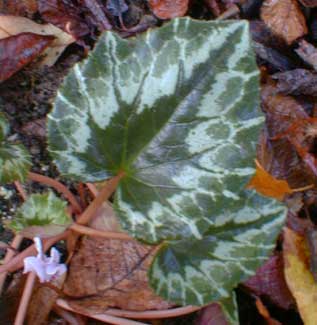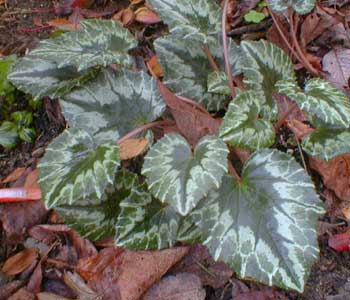
Shell Pink
White-silver Patternleaf
Autumn Cyclamen
"The gentle cyclamen with dewy eye
Breathes o'er her lifeless babe the parting sigh;
And, bending low to earth, with pious hands
Inhumes her dear Departed in the sands.
"Sweet Nursling! withering in thy tender hour,
"Oh, sleep," She cries, "and rise a fairer flower!"
-Erasmus Darwin
(1731-1802)
(1731-1802)
This Cyclamen hederifolium ssp hederifolium has mid-sized 'Shell' blossoms (very pale pink) that begin in September ahead of leaves. Flowering becomes subdued in October as it concentrates on developing his largish leaves, but it will flower again before October's end & continue into November.
This is a Patternleaf variety with closed-tip spearpoint silhouette surrounded by lined or marbled rays of silver that extend to the leaf's deckled edges. The leaves are up by mid-October (when these photos were taken) & will be more numerous in November & last until early spring.
Though broadly categorized as a Silverleaf, a more specific gradation for cyclamen leaves, patterned & unpatterned, includes 1) Pewter-leaf, which is lead or grey-silver, 2) Silver-leaf which is a bright shimmering silver, & 3) White-silver, which looks as though it were painted on with white paint. Since the variations blend one color into the next it can be a difficult judgement on some specimens, but this one is much closer to White-silver than Silver-leaf.
Most growers will not make such fine distinctions but will sell these either as Pewter Group or Silverleaf, which can be all inclusive designations for an amazing array of highly dissimilar leaf types. Such specimens are so variable that seedlings off a single plant will be each as distinct as fingerprints.
 It was once believed that cyclamens could ward off bad winter weather, for when autumn & winter were mildest the C. coum & C. hederifolium collectively bloomed just about continuously.
It was once believed that cyclamens could ward off bad winter weather, for when autumn & winter were mildest the C. coum & C. hederifolium collectively bloomed just about continuously.In Germanic Christian lore cyclamens are known as "Our Lady's Little Ladles" In Catholic symbolism the ladle is symbolic of baptism, but at an older level of myth, the Ladle brought forth drink from the Well of Wisdom. Mary, frequently shown standing upon moon & stars, is indeed a Star-divinity, & her "ladle" is the Dipper hung from the North Star, a constellation also identified by ancient people as the Plow, so that Mary's soup ladle represented agriculture & the feast of plenty, no different from the Goddess Demeter.
Among modern witchcraft practitioners cyclamen oils are used externally or on lit candles to increase sexual desire, happiness, protection, fertility, to assist in distinguishing truth from lies, & to relieve grief or the pain of childbirth. Only external use is recommended since cyclamens are toxic. There is usually a ritual context for use, without which benefit is increasingly doubtful, but ritual can enhance the placebo effect & a general feeling of well being.
The association with witchcraft would not be as positive for everyone as it can be for wiccans. Cyclamens were ancient symbols of the Goddess Hecate or Black Demeter, or Black Aphrodite, because it bloomed when the rest of the plant world was dormant or had disappeared for the winter. Several 17th through 19th Century poets referred to cyclamens in the context of dying or as winter's grave-flowers, & in particular cyclamens could symbolize the death of children, as in the Erasmus Darwin quote at the head of this page, or more recently when Yehuda Amichai (1924-2000) wrote:
"Illusions are childrenIt is not really a contradiction that cyclamens were not merely symbolic of death, resignation, & farewells, but also served poets writing of love. For these allusions do derive from a time when the Mother Goddess or All-mother was ruler simultaneously of Life & Death, & of the seasonal cycle of Fertility & Barrenness.
who went out to find cyclamens in a field
and never back."
Winter, & barrenness, did not only imply death, but also wisdom, by an ancient mystical belief that a woman (or goddess) bereft of children (as Artemis & Cybele were childless; as Sarah was for many years barren, because she was a priestess, & wiser than Hagar who was first to bare) bore treasures more valuable than personal offspring. It is Wisdom that is more precious than all other riches.
That cyclamens were so common throughout the biblical world has lent them continued sacredness, required for biblical gardens. Among the ingredients outlined by God speaking to Moses on the manufacture of Temple incense was aldo kippat ha-yardan [Exodus 30:34], thought to have been cyclamen, "kippat" (circular) being the cyclamen tubers which have the shape of kippot aka yarmulkes (Jewish caps). Kippat is also an epithet for Binah (Understanding) as Upper Shekhinah, the female divine presence of God, called the Canopy of Heaven (kippat ha-shamayim), she that descends to the Wedding Canopy in order to (Aphrodite-like) bless marriages, or descends upon the heads of scholars who pursue understanding of Torah.
Continue to
Cyclamen hederifollium, Silverheart, Shell Pink